History of the Brazilian Navy
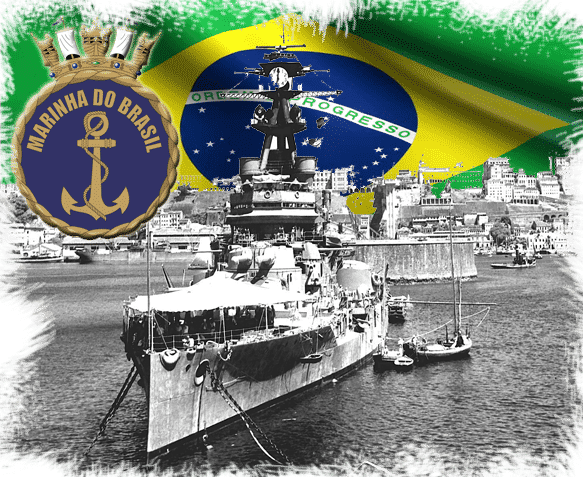
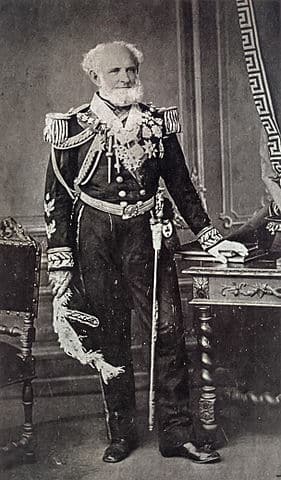 It took its origins from the the transfer of the Portuguese monarchy to Brazil in 1808 during the Napoleonic wars, as personnel and ships became the core of this local Navy, later to be passed on to Brazil.
It took its origins from the the transfer of the Portuguese monarchy to Brazil in 1808 during the Napoleonic wars, as personnel and ships became the core of this local Navy, later to be passed on to Brazil.
With the independence of the country Captain Luís da Cunha Moreira became the first minister of the Navy on October 28, 1822. Soon Lord Thomas Alexander Cochrane was made commander and then “first admiral”, at the head of a mixed force of a single ship of the line, four frigates, and 33 corvettes, sloops and gunboats. This was called the Imperial Brazilian Navy, then under Emperor Pedro I. This navy fought on 4 may 1824, during the revolt in Pernambuco and prior to the Cisplatine War.
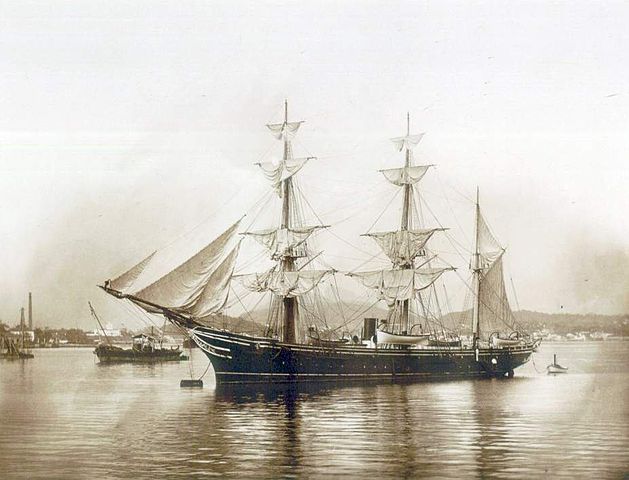
Imperial Marinheiro, Brazilian mixed cruiser. In 1870, the Imperial Brazilian Navy was the fifth largest in the world.
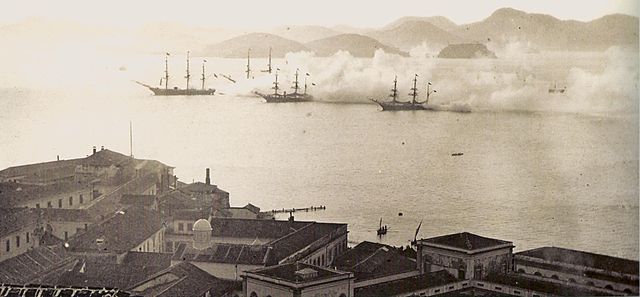
The Imperial Brazilian Navy in training.
Articles:
- Almirante Tamandaré (1890)
- Bahia class cruisers (1909)
- Marcilio Dias class destroyers (1940)
- Minas Geraes class battleships
- Riachuelo (1883)
In the following reign of Pedro II from the 1830s to the 1880s, the Brazilian Navy reached in maximum, ships being built with modern rifled guns at the Naval Arsenal of Rio de Janeiro, Salvador, Recife, Santos, Niterói and Pelotas. They fought numerous revolts and battled their old enemy the Argentinians, especially in the long and bloody Paraguayan War (1849-70).
It was during that time that Brazil ordered about twenty ironclads. In the process, the Navy all but destroyed the Paraguayan navy in the Battle of Riachuelo. In the 1870, Brazil achieve the fifth rank in the world with 94 modern warships, including modern ironclads and coastal battleships.
However the fall of the Imperial regime in 1889 was followed in 1893 by a revolt of the Armada, largely monarchist. Things settled as neighboring Chile and Argentine raised their fleets to a level that threatened Brazil. The new government left the navy indeed without funds, and it fall in quality and numbers well beyond its previous rank.
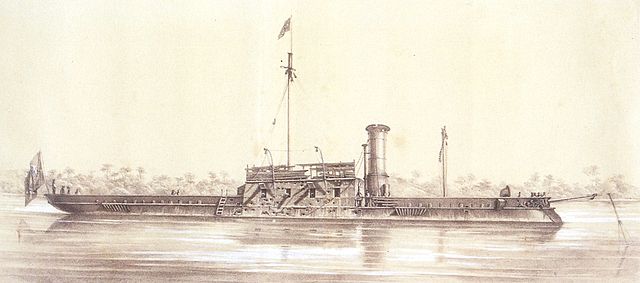
French-built Ironclad Brazil (1864)
However a very important naval law was passed on 30 December 1905, ordering no less than three small battleships, three armored cruisers, six destroyers, twelve torpedo boats, three submarines, and two river monitors. Later on the order was modified when it was learnt about the Dreadnought in construction: The armoured cruisers were dropped and instead two dreadnoughts were ordered in 1906 and that was the start of a famous naval arms race with Argentina and Chile.
The Marina Brazileira in 1914
It was an important fleet in 1914, first in tonnage in South America, ahead of Argentina and Chile. This navy owed this supremacy to the ambitious choice of having Dreadnoughts even though this type had just made its appearance within the English fleet. At the turn of the century, Brazil was entering a golden age of prosperity unique in South America.
Controlling the world market for coffee and rubber, Brazil benefited from large investments from European and American companies and real financial empires were created, as well as new towns, sometimes in the heart of the jungle. Political agitation which saw the early republic born and border wars has come to an end, and people founded great hopes in the century to come.

Sao Paulo in 1917
In 1905, the government set up a vast program to give the country the vest fleet in South America. In a very short time, two Dreadnoughts, two cruisers, ten destroyers and three submarines were ordered, mostly in UK. The order of the two dreadnoughts Sao Paulo and Minas Gerais caused a great deal of concerns worldwide in 1906: These ships were on paper much more powerful than the HMS Dreadnought and even her successors in the yard.
But moreover large traditional maritime powers such as France and Russia still don’t have even themselves ordered such ships. There were rumors, especially about the possibility that these ships has been secretly ordered by Germany through Brazil for a planned resell.
These speculations were based on the fact that German investors were present in strength in Brazil and there was real paranoia in the press and in the population in UK about the ongoing battleship race with Germany.
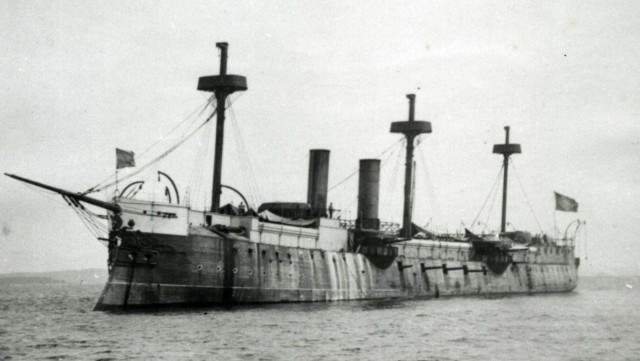
Protected cruiser Almirante Tamandare in 1890, before refit
In 1910, when Brazil received its battleships and nothing else happened, the government announced the order of the Rio de Janeiro (future HMS Agincourt). With these three major units, Brazil could have grow as the largest maritime power of the South Atlantic. But ordered too late, and suffering the consequences of an economic crisis, the Rio de Janeiro was sold to Turkey, and then requisitioned by the RN at the time of the outbreak of the great war.
Moreover, on November 22, 1910, a mutiny erupted on Minas Gerais and political unrest accompanied a sudden economic recession. Future plans to strengthen the fleet were cancelled for long. The mutiny was relatively similar to the one that occured a few years before on the Russian potemkine, over living and working conditions of sailors. It was called the revolt of the Lash and died down after reforms were passed on the 26th of November 1910.
The Marina Do Brazil in WW1
In 1914, Brazil was nevertheless at least on paper lining up a powerful fleet, capable of forbidding access to the southern Atlantic to any German squadron. But due to both a poorly digested economic crisis and an isolationism doctrine inherited from US Monroe policy, Brazil took a cautious position of neutrality, especially in regards of exports still vital for both sides for local economy.
From 1916 onwards, however, U-Boats increasingly attacked Brazilian merchant ships, suffering at some point a total blockade of its coffee exports. In 1917, with unrestricted submarine warfare traffic losses intensified, and Brazil eventually declared war on October 24, 1917 on Germany.
A squadron was set up to operate in northwestern Africa, consisting of 2 cruisers, 4 destroyers and support ships. But it was only in operation three months before the capitulation. In southern Atlantic the rest of the fleet participated in convoys escort duties. The two battleships were sent for modernization to an American shipyards in order to integrate these into the British Grand Fleet, but the war ended before they left the shipyards.
The treaty of Versailles recognized war reparations to Brazil which consisted of two old destroyers and 43 merchant ships flying German flag, interned or captured during the war.
Order of Battle
4 Battleships: Dreadnoughts: 2 class Minas Gerais. (One more planned for 1914: Rio de Janeiro). Older: Two buildings class Marshal Deodoro (1898).
6 Cruisers: 2 Bahia class (1909). Almirante Tamandare (1890), Republica (1892), Almirante Barrozo (1896). School Cruiser Benjamin Constant (1892).
15 Destroyers: 10 Para Class (1909), Tiradentes, Sampaio, Tamoio, 2 class Tupi.
12 Miscellaneous: Gioas torpedo boat (1907), 2 class Panne (1892, ex-German), Marcilio Diaz (1893), 3 submersibles class F1 (built in Italy in 1913), Pernambuco (fluvial monitor), 2 class Acre gunboats, 2 class Teffe gunboats, Ceara tanker, River monitors class Javari (ordered 1914).
Notes:
In 1916, the Italians delivered the supply vessel Ceara to Brazil. The battleship Rio was then sold under construction to the Turks and then requisitioned.
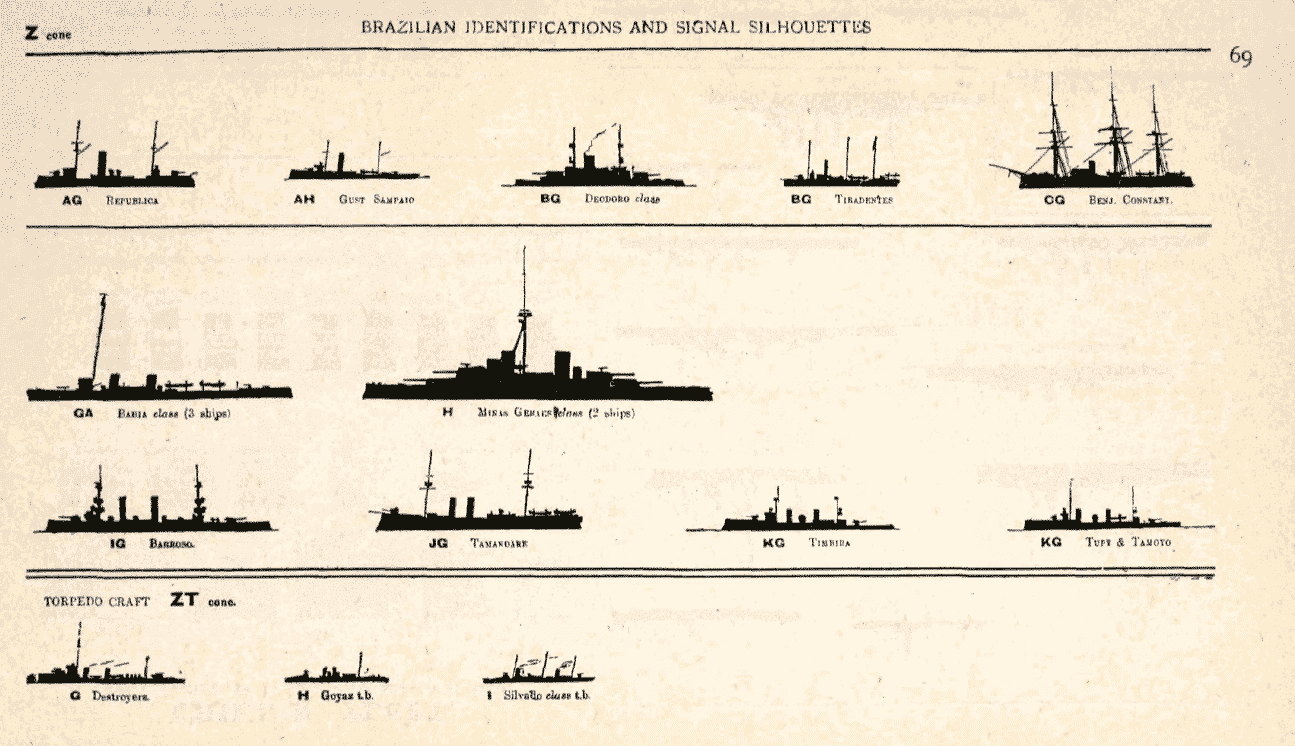
Identification Silhouettes of the Brazilian Navy in 1914.
Gallery
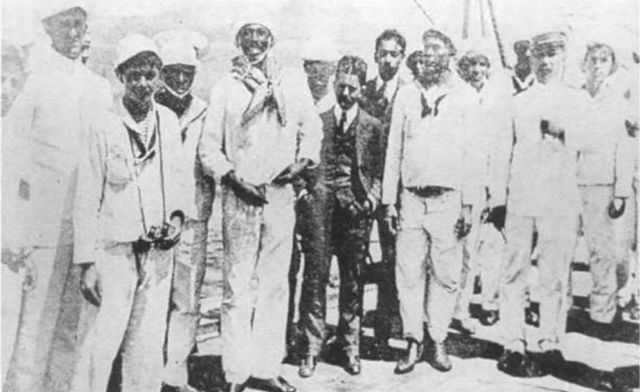
Mutiny on Minas Gerais, 1910
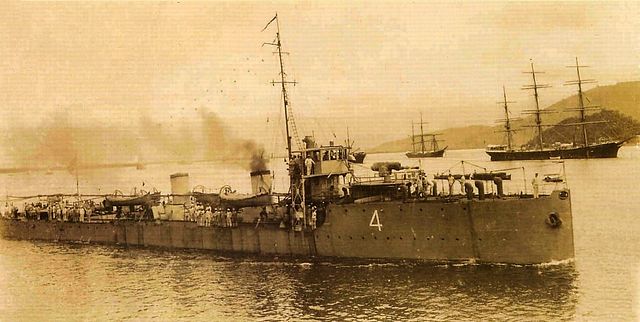
Destroyer Rio Grande do Norte
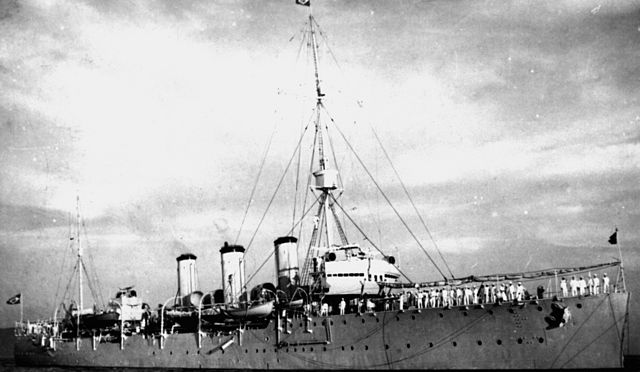
Cruiser Bahia

Coastal battleship Deodoro (1898)
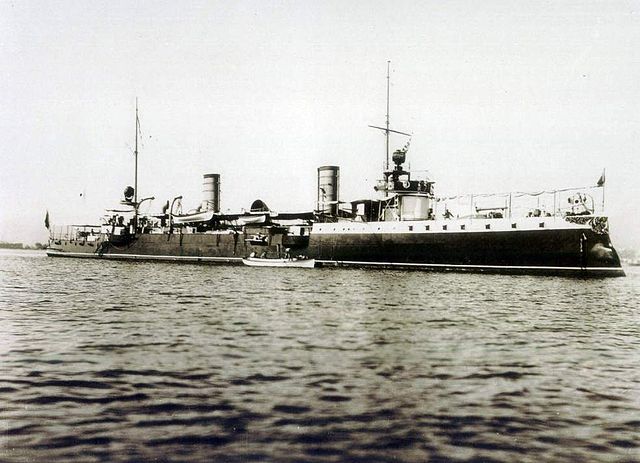
Tupi class torpedo cruiser
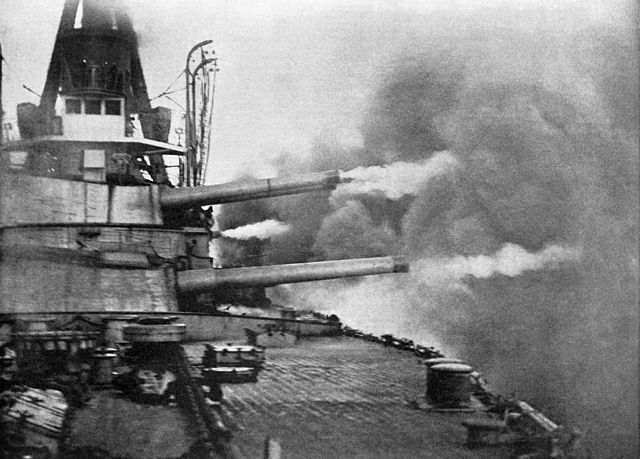
Broadside from the Minas Gerais in exercizes
Sources
en.wikipedia.org Brazilian_Navy
en.wikipedia.org Brazil_during_World_War_I
en.wikipedia.org South American dreadnought race
marinha.mil.br/ historia-naval
marinha.mil.br/papem/


 Latest Facebook Entry -
Latest Facebook Entry -  X(Tweeter) Naval Encyclopedia's deck archive
X(Tweeter) Naval Encyclopedia's deck archive Instagram (@navalencyc)
Instagram (@navalencyc)





 French Navy
French Navy Royal Navy
Royal Navy Russian Navy
Russian Navy Armada Espanola
Armada Espanola Austrian Navy
Austrian Navy K.u.K. Kriegsmarine
K.u.K. Kriegsmarine Dansk Marine
Dansk Marine Nautiko Hellenon
Nautiko Hellenon Koninklije Marine 1870
Koninklije Marine 1870 Marinha do Brasil
Marinha do Brasil Osmanlı Donanması
Osmanlı Donanması Marina Do Peru
Marina Do Peru Marinha do Portugal
Marinha do Portugal Regia Marina 1870
Regia Marina 1870 Nihhon Kaigun 1870
Nihhon Kaigun 1870 Preußische Marine 1870
Preußische Marine 1870 Russkiy Flot 1870
Russkiy Flot 1870 Svenska marinen
Svenska marinen Søværnet
Søværnet Union Navy
Union Navy Confederate Navy
Confederate Navy Armada de Argentina
Armada de Argentina Imperial Chinese Navy
Imperial Chinese Navy Marinha do Portugal
Marinha do Portugal Mexico
Mexico Kaiserliche Marine
Kaiserliche Marine 1898 US Navy
1898 US Navy Sovietskiy Flot
Sovietskiy Flot Royal Canadian Navy
Royal Canadian Navy Royal Australian Navy
Royal Australian Navy RNZN Fleet
RNZN Fleet Chinese Navy 1937
Chinese Navy 1937 Kriegsmarine
Kriegsmarine Chilean Navy
Chilean Navy Danish Navy
Danish Navy Finnish Navy
Finnish Navy Hellenic Navy
Hellenic Navy Polish Navy
Polish Navy Romanian Navy
Romanian Navy Turkish Navy
Turkish Navy Royal Yugoslav Navy
Royal Yugoslav Navy Royal Thai Navy
Royal Thai Navy Minor Navies
Minor Navies Albania
Albania Austria
Austria Belgium
Belgium Columbia
Columbia Costa Rica
Costa Rica Cuba
Cuba Czechoslovakia
Czechoslovakia Dominican Republic
Dominican Republic Haiti
Haiti Hungary
Hungary Honduras
Honduras Estonia
Estonia Iceland
Iceland Eire
Eire Equador
Equador Iran
Iran Iraq
Iraq Latvia
Latvia Liberia
Liberia Lithuania
Lithuania Mandchukuo
Mandchukuo Morocco
Morocco Nicaragua
Nicaragua Persia
Persia San Salvador
San Salvador Sarawak
Sarawak Uruguay
Uruguay Venezuela
Venezuela Zanzibar
Zanzibar Warsaw Pact Navies
Warsaw Pact Navies Bulgaria
Bulgaria Hungary
Hungary

 Bundesmarine
Bundesmarine Dutch Navy
Dutch Navy Hellenic Navy
Hellenic Navy Marina Militare
Marina Militare Yugoslav Navy
Yugoslav Navy Chinese Navy
Chinese Navy Indian Navy
Indian Navy Indonesian Navy
Indonesian Navy JMSDF
JMSDF North Korean Navy
North Korean Navy Pakistani Navy
Pakistani Navy Philippines Navy
Philippines Navy ROKN
ROKN Rep. of Singapore Navy
Rep. of Singapore Navy Taiwanese Navy
Taiwanese Navy IDF Navy
IDF Navy Saudi Navy
Saudi Navy Royal New Zealand Navy
Royal New Zealand Navy Egyptian Navy
Egyptian Navy South African Navy
South African Navy






























 Ukrainian Navy
Ukrainian Navy dbodesign
dbodesign